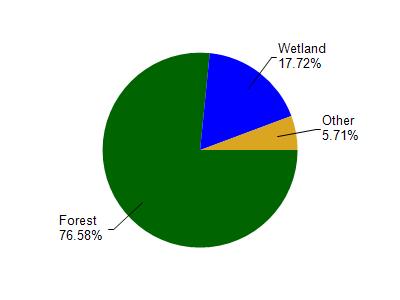Forest
Yes
Yes
No
Fish and Aquatic Life
Historical Description
The Brule River originates at Brule Lake in Michigan's Upper Peninsula, flowing
southeast for 53 miles until it joins the Michigamme River to form the Menominee River
just northeast of the village of Florence. The Brule River is a Wisconsin-Michigan
boundary water. It is classified as trout waters from the bridge at Hwy 2 upstream to its
headwaters. Brook trout, brown trout and rainbow trout are present. Below the bridge
at Hwy 2, the Brule is classified as a warm water fishery. Walleye, northern pike,
largemouth bass, smallmouth bass, and panfish are present.
Michigan's Iron River is a major tributary of the Brule. Iron mine drainage along that
river has polluted the Brule in the past. Abatement programs have attempted to correct
this problem.
The Brule is an intensively used recreational resource. Canoeing, rafting, boating,
sightseeing and fishing are popular along the river's length.
Date 1993
Author Surface Water Inventory Of Wisconsin
Management Goals
Wisconsin's Water Quality Standards provide qualitative and quantitative goals for waters that are protective of Fishable, Swimmable conditions [Learn more]. Waters that do not meet water quality standards are considered impaired and restoration actions are planned and carried out until the water is once again fishable and swimmable
Management goals can include creation or implementation of a Total Maximum Daily Load analysis, a Nine Key Element Plan, or other restoration work, education and outreach and more. If specific recommendations exist for this water, they will be displayed below online.
Monitoring
Monitoring the condition of a river, stream, or lake includes gathering physical, chemical, biological, and habitat data. Comprehensive studies often gather all these parameters in great detail, while lighter assessment events will involve sampling physical, chemical and biological data such as macroinvertebrates. Aquatic macroinvertebrates and fish communities integrate watershed or catchment condition, providing great insight into overall ecosystem health. Chemical and habitat parameters tell researchers more about human induced problems including contaminated runoff, point source dischargers, or habitat issues that foster or limit the potential of aquatic communities to thrive in a given area. Wisconsin's Water Monitoring Strategy was recenty updated.
Grants and Management Projects
Monitoring Projects
| WBIC | Official Waterbody Name | Station ID | Station Name | Earliest Fieldwork Date | Latest Fieldwork Date | View Station | View Data |
|---|
| 703900 | Brule River | 10007695 | Brule River at Gaspardo Rd | | | Map | Data |
| 703900 | Brule River | 10002350 | Brule River Flowage | 6/12/2006 | 4/25/2011 | Map | Data |
| 703900 | Brule River | 10002345 | Brule River - 06 Carney Dam | | | Map | Data |
| 703900 | Brule River | 10002346 | Brule River - 10 Pentoga Bridge | | | Map | Data |
| 703900 | Brule River | 10037271 | Brule River -- Access at Hwy 55 Bridge MI / WI Border | | | Map | Data |
| 703900 | Brule River | 10007696 | Brule River at Sth 55 | 9/12/2024 | 9/17/2024 | Map | Data |
| 703900 | Brule River | 10002347 | Brule River - 14 Below Iron River | | | Map | Data |
| 703900 | Brule River | 213152 | Brule River - Upstm End Usfs 2172 | 10/19/1994 | 11/9/1994 | Map | Data |
|

Watershed Characteristics
Brule River is located in the Brule River watershed which is 194.73 mi². Land use in the watershed is primarily forest (76.50%), wetland (17.70%) and a mix of grassland (2.90%) and other uses (2.80%). This watershed has 192.50 stream miles, 2,169.69 lake acres and 13,322.90 wetland acres.
Nonpoint Source Characteristics
This watershed is ranked Low for runoff impacts on streams, Not Ranked for runoff impacts on lakes and Low for runoff impacts on groundwater and therefore has an overall rank of Low. This value can be used in ranking the watershed or individual waterbodies for grant funding under state and county programs.However, all waters are affected by diffuse pollutant sources regardless of initial water quality. Applications for specific runoff projects under state or county grant programs may be pursued. For more information, go to surface water program grants.